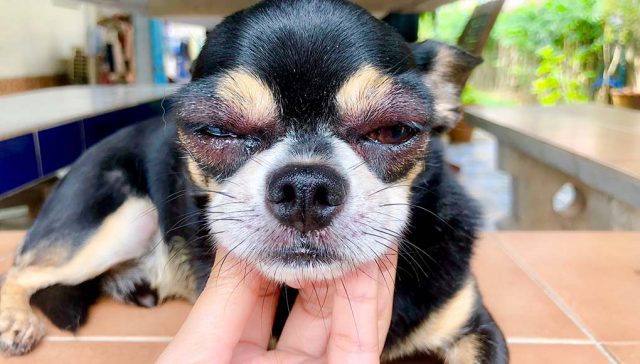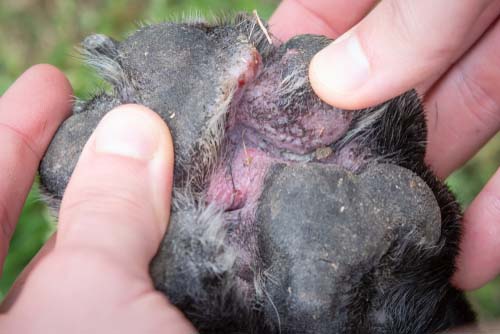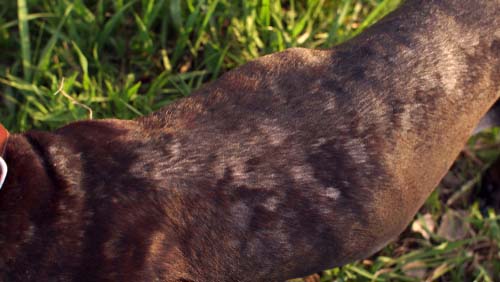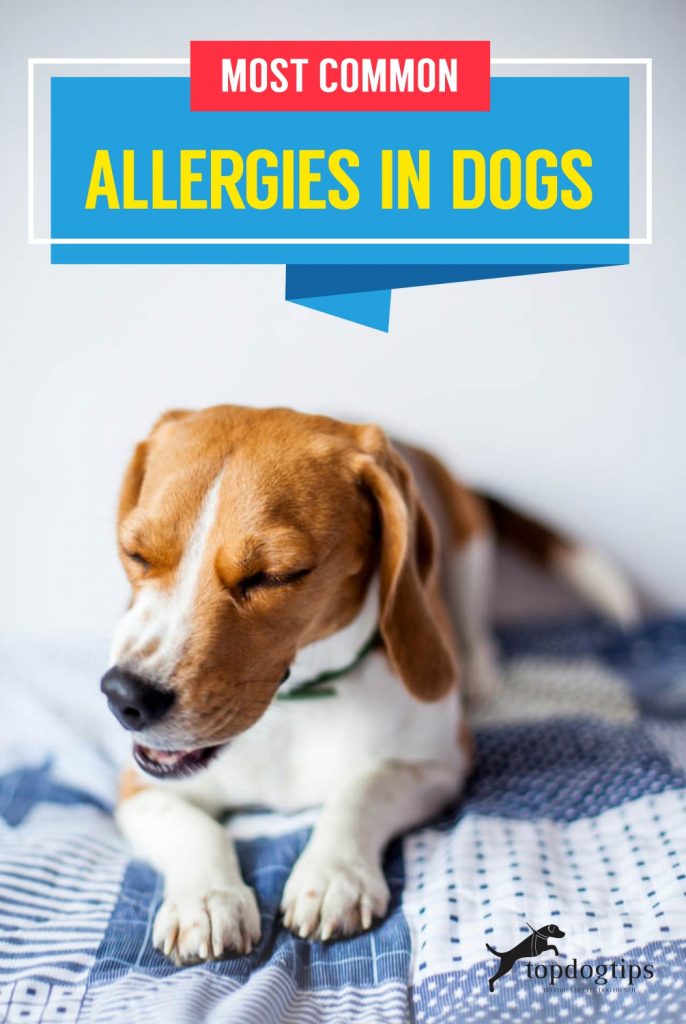
It may seem odd, but allergies are more common than you think in our canine best friends.
Rashes, excessive scratching, sneezing, runny eyes, shaking of the head, gnawing, chewing, and infection are all signs of a possible allergic reaction.
These could be triggered by different allergens, including certain ingredients in food, chemicals, environmental elements, seasonal triggers, toxic plants, and more.
Also, certain breeds like Pugs, English Bulldogs, Boston Terriers, Labradors, Cocker Spaniels, Golden Retrievers, and Pit Bull Terriers are more likely to develop allergies than others.
Here are some routine allergies all dog owners should be aware of.
Dogs' Most Common Allergies
1. Food Allergy
According to studies, food accounts for 10% of all canine allergic reactions.
That is a huge percentage, but it’s important to remember that there’s a difference between food sensitivity or intolerance and a true food allergy.
If there are symptoms like hives, swelling, itchiness, diarrhea, vomiting, or a rare but severe reaction like anaphylaxis—chances are your pooch is actually allergic to something in his food.
Common food allergens include proteins like beef and chicken, dairy, wheat, eggs, and soy.
If you suspect this to be the case, take your dog to the vet immediately.
It’s vital not just to handle the symptoms but to investigate the source of the reaction as well. Afterward, we have a resource for how to feed dogs with food allergies.
2. Flea Allergy Dermatitis (FAD)
Fleas are a common cause of excessive itching and inflammation in dogs.
In fact, it only takes a single flea’s saliva to incite a pretty powerful reaction!
Thankfully, this problem can be easily diagnosed and solved by applying a product that kills fleas, like a spot-on treatment.
In extreme cases, you may even have to resort to oral antihistamines, steroids, and antibiotics.
Comb your pooch daily and inspect him closely, give him regular baths with a sulfate-free shampoo, and use a vet-recommended product to get rid of an existing infestation. It’s as simple as that.

3. Atopic Dermatitis
This allergic skin reaction is usually seasonal and is caused by hypersensitivity to dust mites, pollen, certain plants, and mold spores.
Symptoms include redness, soreness, and itching, which, if left untreated, could lead to flaking and infection.
There is no simple cure for Atopy, unfortunately, but management is certainly possible.
Ask your vet for a medicated shampoo that will help reduce the discomfort and itching.
Clean your home often and if possible switch to non-toxic products.
Avoid keeping them in a room that is carpeted, and cover their beds with a plastic sheet to keep dust mites away.
Lastly, keep your dog’s skin moisturized by using conditioners with ceramides in it. In severe cases, antihistamines and antibiotics may be necessary.
4. Houseplant Allergy
There’s no denying that plants liven up our homes with their striking foliage. However, not all plants are dog-friendly.
In fact, some are incredibly dangerous and could cause reactions like rashes, vomiting, diarrhea, difficulty breathing, seizures, and severe itching.
Common poisonous plants include Sago Palm, Fiddle Leaf Fig, Azalea, Aloe Vera, Dieffenbachia, Bird of Paradise, and Lantana.
Furbabies are notorious for chewing anything they can get their teeth on, and it’s impossible to watch your furbaby 24/7, so it’s best to avoid these toxic houseplants.

5. Contact Allergy
Also known as Contact Dermatitis, a contact allergy usually manifests itself in the form of irritation, redness, or a rash. As the name suggests, this simply means that your pooch has come in contact with something that triggered a reaction.
It can be tricky to find the source, especially if it’s repetitive, but try to follow him through his daily routine to identify the cause.
Common culprits include chemical cleaners, salt on the road, room fresheners, perfumes, fabrics, or, as mentioned in the previous point, certain houseplants.
If you can’t figure it out on your own, consult a vet who will usually resort to a patch test to get to the bottom of it.
6. Reaction to Medication
As with us, certain medicines may not sit well with your dog. Whenever your vet prescribes something new, make sure that you monitor your dog for possible allergic reactions.
These could include gastrointestinal reactions, hives, rashes, itching, swelling, and, in serious cases, trouble breathing and low blood pressure.
If you spot any of these, contact your vet immediately. Avoid self-medicating your pooch at all costs, especially with human medicines.
7. Reaction to Shampoos and Soaps
If your dog is suddenly exhibiting symptoms like rashes, irritation, and soreness of the skin, one possible cause could be a recent change of shampoo or soap.
Medicated shampoos, in particular, may have harsh ingredients that could make their immune system release histamine.
If this is the case, first rinse off any areas that came in contact with the new shampoo, then consult your vet for a topical antihistamine that will take care of the reaction.
If it persists, your vet may prescribe stronger medicines or oral antihistamines.

8. Acute Reaction
Severe allergic reactions are, without a doubt, the most frightening of the lot, as these can have fatal effects if not treated on time.
Usually, anaphylaxis in dogs is caused by bee stings, insect bites, antigens in vaccines, and certain chemicals.
Symptoms include itching, hives, excessive drooling, vomiting, and diarrhea. In a systemic anaphylactic reaction, you may notice difficulty breathing and a bluish tinge to the gums and tongue.
Thankfully, they are rare in dogs, but if they do happen, rush him to the vet as he will need immediate treatment and possibly antihistamines.
Most Common Allergies in Dogs: Diagnosis and Treatment
It may not always be easy to diagnose what’s causing your pooch to have an allergic reaction, but you’ve got to try.
The vet may suggest allergy testing to determine the root but even this could be inconclusive.
There are also genetic factors that make certain dogs predisposed to developing allergies, and this makes life even more complicated!
If there is a conclusive answer, however, the best way to treat the allergy is to avoid the cause altogether.
For example, if it’s a food allergy, come up with a vet-approved diet that keeps those ingredients out of the picture.
If he’s allergic to grass, trim your garden as often as possible. If the cause is a chemical cleaner, switch to a natural, non-toxic option.
It’s all about precautions and management to give your dog as comfortable and allergy-free a life as possible!
READ NEXT: 10 Vaccines That Dogs May Be Allergic To













